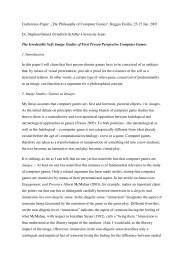Playing Dress-Up: Costumes, roleplay and imagination
Playing Dress-Up: Costumes, roleplay and imagination
Playing Dress-Up: Costumes, roleplay and imagination
You also want an ePaper? Increase the reach of your titles
YUMPU automatically turns print PDFs into web optimized ePapers that Google loves.
<strong>Playing</strong> <strong>Dress</strong>-<strong>Up</strong> Ludica<br />
purchase virtual merch<strong>and</strong>ise from an auction web site within the game’s browser, but outside of<br />
the 3D world. In addition, players may “try on” clothing items prior to purchase, critically, for<br />
others to see. Conversely, in Second Life, all virtual merch<strong>and</strong>ise is purchased in-world at specific<br />
sites. Designers generally acquire real estate (the main revenue source for the world’s operators)<br />
<strong>and</strong> set up stores, where players can purchase items viewed via 2D screenshots, <strong>and</strong> allowing<br />
players to try on garments before purchase is at the seller’s discretion. All clothing in Second Life<br />
is player-created, <strong>and</strong> while many designers sell their fashions for virtual currency, there is also<br />
an extensive practice of clothing give-aways, which allows players to obtain an order of<br />
magnitude or two more clothing than in There.com, where all clothing must be purchased with<br />
virtual currency. In World of Warcraft, where dress-up is more instrumentalized, clothing items<br />
are obtained either as booty from combat or quests (known colloquially as “drops”) or purchased<br />
from non-player merchant bots or other players via auction. Clothing can also be “crafted,” but<br />
this entails gathering enough resources (such as linen or silk) to create a st<strong>and</strong>ard item, rather than<br />
the original designs afforded by worlds such as There.com <strong>and</strong> Second Life. There.com, which<br />
arguably has the most extensive mechanic around dress-up play, is the only virtual world we are<br />
aware of that actually awards points for dress-up. While this social “metaverse” is not a linear<br />
goal-based game in the traditional sense, it does have the ability to “level” in various categories,<br />
such as Explorer, Hoverboarder, Socializer, <strong>and</strong> of course, Fashionista, towards which players are<br />
awarded points every time they try on, change or purchase clothes. A related mechanic in Second<br />
Life allows players, for a small fee in virtual currency, to award other avatars points for<br />
“appearance,” making the point system more social. Because of the expense of obtaining such<br />
points, players take great pride in a high appearance score.<br />
Figure 4: A wedding party in There.com, with women’s<br />
slacks substituting for skirts. (Image: Pearce)<br />
Figure 5: Twinking in There.com is represented with a<br />
gift box animation. (Image: Pearce)<br />
• Twinking/Gifting/Trading: Twinking is the popular MMOG practice of giving items away to<br />
lower-level players. Though not a game-mechanic per se, it is a pervasive play pattern that can<br />
only take place in a context where the trading or giving away of items is integrated as a design<br />
feature. In World of Warcraft, the mechanic is one of trading, although players often give away<br />
things in exchange for nothing. In both Second Life <strong>and</strong> There.com, there is a gifting mechanism,<br />
<strong>and</strong> in the latter, giving a gift is accompanied by an animation (visible to all) of a wrapped gift<br />
passing from one avatar to the next. Players can both give <strong>and</strong> loan clothing items to each other in<br />
this fashion, which can also serve as a kluge for a try-on mechanic when the game does not<br />
possess one already. Needless to say, twinking has significantly different ramifications in games<br />
with instrumental dress-up play versus more paidia/expression-oriented environments. A very<br />
small number of games provide actual rewards for twinking, such as the now-defunct Game<br />
Philosophy of Computer Games 2007 Page 7






